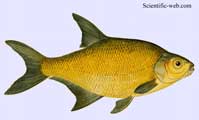The carp bream (Abramis brama) (or simply bream in the UK) is a species of fresh-water fish belonging to the family Cyprinidae. Range The bream's home range is in Europe north of the Alps and Pyrenees, as well as in the Balkans. It is also found as far east as the Caspian Sea, the Black Sea, and the Aral Sea. Description The carp bream is usually 30 to 55 centimeters (12 to 20 inches) long, though some specimens have been as long as 75 cm (30 in.), and weighed two to four kilograms (four to nine pounds). It has a laterally flattened and high-backed body and a slightly inferior mouth. The fish is a silvery gray color, though older fish can be bronze-colored especially in clear waters. The fins are grayish to black and never colored. Similar-looking fish It can easily be confused with silver bream (Blicca bjoerkna), in particular at the younger stages (see picture). The most reliable method is counting the scales in a straight line from the first ray of the backfin to the lateral line. White bream has less than ten scales, carp bream 11 or more. At the adult stage the reddish implant of the pectoral fin of the Silver Bream is a very clear mark. Like all cyprinidae carp bream can easily hybridize with other species. Habitat The carp bream generally lives in rivers (especially in the lower reaches) and in nutrient-rich lakes and ponds with many algae and muddy bottoms. It can also be found in brackish sea waters. Feeding habits It lives in schools near the bottom. At night carp bream can feed close to the shore and in clear waters with sandy bottoms the feeding pits can be seen during daytime. The fish's protactile mouth helps it dig for chironomidae larvae, tubificidae, bivalves, and gastropods. The carp bream eats water plants and plankton as well. In very turbid waters bream can occur in large numbers which can result in a shortage of bottom feeds like chironomidae. The carp bream is then forced to start filter feeding with its gill rakers with Daphnia as the main prey. As the fish grows the gill rakers grow to far apart to catch its prey and the bream will not grow bigger than 40 cm. If a carp bream is malnourished it can develop a so-called knife back, the formation of a very sharp edge along its back. Spawning The spawning time of the carp bream is from April to June, when water temperatures are around 17°C (63°F). In this time the males form territories in which the females lay their 100,000 to 300,000 eggs on water plants. The fish larvae hatch after three to twelve days and attach themselves with special adhesive glands to water plants until their yolk is used up. The young fish are often not recognized as bream for their slender posture, they are recognizable by their flat body shape and silvery color. At this stage the fish is still pelagic, but in a few months the fishes take their typical body shape and become bottom dwellers. After three to four years the fish are sexually mature.
Retrieved from "http://en.wikipedia.org/" |
|

